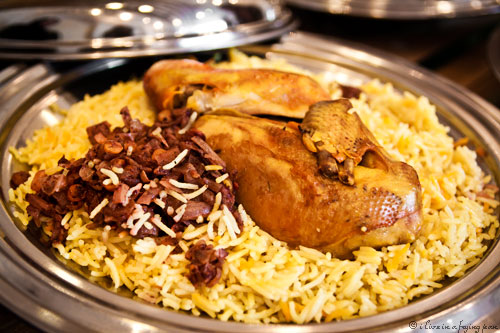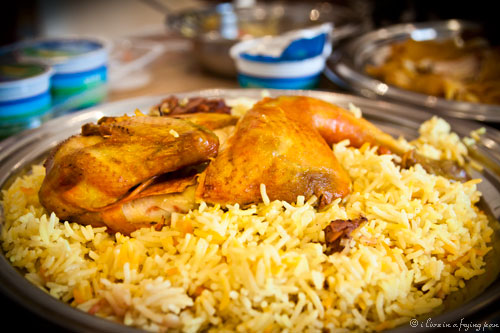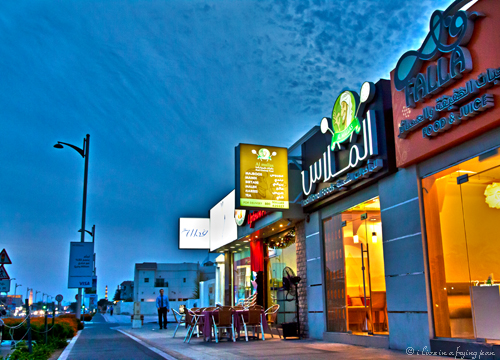 Did you eat hummus to celebrate UAE National Day? Maybe falafels? Or mandi? Or shawarma?
Did you eat hummus to celebrate UAE National Day? Maybe falafels? Or mandi? Or shawarma?
Well, that’s all yummy enough. But none of them are really Emirati.
Here’s one of the few places where you could have really tasted true Emirati cuisine – Al Mallas. An enterprising Emirati lad, Esam Al Obthani, opened this tiny Emirati gem of a place and the juice bar right next to it on Beach Road.(check out this article for the deets)
I love that the restaurant is tiny – barely big enough to squish together 4 or 5 tables – and has a focused menu that doesn’t leave me hyperventilating over innumerable options. I know it’s somewhat anachronistic and totally out-of-place to be proclaiming this in Dubai, but really, less is more.
And with that profound statement, let’s move onto the food. If you’ve never tried Emirati food, think of what you’d do if you had to concoct a cuisine in the middle of the desert, with your only luxury potentially being summertime access to the waters of the Gulf. If I were given the chef’s hat in the desert, we’d all end up becoming craggy emaciated shrubs and get buried hungry under the dunes. Seriously, try making chicken tikka masala or beef bourguignon in the desert. Not happening.
But thankfully, the Bedouins were resourceful, and did whatever they could with whatever they had. It’s pretty basic fare: meat, rice, fish, and preserved ingredients that keep well in the desert – like ghee or salted fish. With Islam radiating out from the Arabian Peninsula, and with maritime trade playing a critical role over centuries, the ‘basic fare’ became altered by culinary diffusion. They adopted the spices and seasonings of those who were conquered, those who conquered, and those who came to trade.
My point in saying all of this, is really that authentic Emirati food isn’t massively spiced, seasoned, or convoluted to make the fantastical dishes you might have come to expect in restaurants these days. When I go to eat real Emirati fare, I go to appreciate flavours that are simple, back-to-basics, wholesome, and homely. And ideally, some pretty tender meats and fresh seafood.
On the note of tender meat, it broke my heart that Al Mallas didn’t have slow-cooked lamb, or gouzi, that day. But tears aside, let’s talk about their Biryani…
…which incidentally, is not Emirati either, but an imported dish from India or Iran, depending on which biryani-originator camp you’ve elected to be in. The biryani at Al Mallas was a different rice and chicken breed altogether, I wouldn’t have called it biryani had I not already known what it was.
The chicken had been boiled in a mix of spices (baharat), and then baked – something I’ve never heard of in a biryani recipe. This double technique vaguely reminded me of Peking Duck, where boiling, scalding or blanching the duck helps to tighten and stretch the skin, making it more crisp-able during the roasting process. And true enough, the skin of the chicken was stretched taut and crisped up, with insides that were bland but fairly moist.

The kicker element of the dish was actually the well-seasoned rice that swooshed the fragrance of whole cardamom and chicken stock all round my mouth with the first bite, and the munchy fried onion and mung bean mix that had been spooned over on one edge of the dish.
This is an ancient Bedouin dish that simply places boiled meat and thick-cut veggies over layers of crackly, unleavened bread soaked in meat stew. It’s one that the Arabian Peninsula can claim as its own, though modified over time with spices and seasonings that have filtered in from India, Iran and Iraq. It’s also known as Tashreeb (Annia Ciezaldo; Day of Honey: A Memoir of Food, Love and War), and is mentioned all the way back from the times of the Prophet Mohammad (PBUH).
While the boiled chicken in Al Mallas’ version was somewhat dry and nothing to write home about, the layers of thin regag bread were all soaked up and pasty just the way they’re meant to be. If you like warm, mushy bread soaked in stew – I do at times. There can something quite comforting about it. –you might fancy ordering Thareed.
Preserved, salted fish (maleh) buried under (tahtah) rice. Now here was an eye-opener. There were thick, dense chunks of chewy fish, almost the texture of beef jerky, enclosed in a coffin of orange-white rice. When I took the first bite, the fish bulldozed me over with an intense salty explosion, leaving my tongue smacking like it would after a pack of extra salted, salt n’ vinegar chips. The salty onslaught on my tongue receded to make way for a tantalizing combination of what hinted of tomato, pepper, maybe preserved lemons (loomi) – it was some sort of tangy, peppery essence that together with the salt, got all the juicy taps in my mouth gushing with greed to continue the taste test. The final after-taste was that of fish – just enough to remind you of what the protein had started out being before it had morphed into a jerky-like leather through the preservation process.
Maleh is undoubtedly an acquired taste. It’s like the bitter gourd of fish. I can bet it would taste great if chopped into tiny slivers and sprinkled over a salad or subbed out for anchovies in a dressing.
I’ve tried Harees twice before in Dubai. It often looks like a marsh of limp gloop waiting to suck you in and strangle you with congealed meat and wheat pulverized together. But shockingly, Al Mallas actually does a decent version ringed in with a narrow moat of ghee. I won’t say I was beating my chest for buckets more of Al Mallas’ version, but I did catch myself dipping my spoon in for multiple dollops from the wheat-coloured gruel. It was smooth, palatable, and nothing like the gummy substance that threatened to fasten my jaws together irreversibly during a disturbing experience from the past that I can’t seem to nuke out of my mind.
I’ve written about my love for Legeimat (or Luqaimat) before on The National, and I’m so blitheringly lazy that I’m going to plagiarize from my own article:
Luqaimat is an Emirati dessert, one that mirrors the loqoumades that were presented as “honey tokens” to winners of the Olympics in Ancient Greece. In Arabic, the word misleadingly refers to small bites. Misleading, because the ping-pong-sized dough balls can be so addictive that they eventually snowball into a colossal dessert binge. While they closely resemble doughnut holes, luqaimat batter is distinct in that it replaces the butter or shortening with yogurt. This gives the fritters a faint sour taste, with insides that are less fluffy than doughnuts, but more squidgy and ideal for sponging up the saffron and cardamom sugar syrup they are typically doused in.
The fritters at Al Mallas emerged piping hot, with the smell of fried dough screaming right through my nostrils into my brain: I WANT YOU. Each fritter had a scalding trail of dibs (date honey) twirled over the outside, and a spongy yellow inside that was pricked with a toothpick before being transported to a very eager and willing mouth. Sips of karak chai quickly washed the deep-fried naughtiness down before it had time to linger on my conscience.
Now I’m actually not sure that what we ate at Al Mallas were legeimat, even though that’s what the ‘sticky balls’ were called on the menu. I realize this is a dangerous claim, coming from a non-Emirati at an Emirati restaurant. But if you read Chef Khulood Atiq’s book on Emirati recipes, you’d also be guilty of suspecting these fluffy balls of being the deep-fried globes of foga, and not the shallow-fried, slightly flattened legeimat. Whatever they were, they were good and deadly addictive.
There’s a charm in eating at Al Mallas. The aluminium serving bowls with scalloped designs and matching lids were placed on the table without any additional tableware. You’re meant to eat with your hands, and any request for plates will be greeted with an assortment of randomly shaped and sized containers scavenged from the kitchen in a desperate attempt to deal with the foreign request. They also have these unbalanced tissue holders that have a life of their own and keep snapping off the table, with their clean resident sheets flying all across the floor, much to the mortification of the diner (I’m sure my clumsiness had everything to do with this). As an added perk, we also received free pulpy mango juice samples from their sister juice bar next door.
With so many foodies in Dubai cribbing about the lack of Emirati food in the city, I’m shocked to see that not every one of the five tables in this restaurant was full. There are people making inroads into Emirati cuisine – whether it’s…
…the breakfast or lunch discussions at the popular Sheikh Mohammad Centre of Cultural Understanding,
…the comprehensive array of authentic dishes at the heritage-themed Al Fanar (they’ve got some killer prawns and a thareed that grows on you through the meal, until you end up begging for it to be packed cause you can’t bear to part with the leftovers),
…the evening snacks – Legeimat and Regag – at the Heritage and Diving Village near Shindagha,
…a couple of breakfast dishes and desserts at Biker’s Café,
…the gouzi at Hadeerah at Bab al Shaams, hauled up from its cooking spot under the ground,
…selected dishes in the buffet spread at Al Dawaar restaurant, Hyatt Regency (though I can’t claim to have tried them)
…’public kitchens’ all over town (esp. the older areas and Al Quoz) that provide takeout service,
…and the home-based Emirati mothers who’ve been serving the Emirati community for years and years now. That best-kept secret has been exposed by the founders of Barzh.com
A part of me senses that the charm of eating these dishes would be amplified in the desert. Can you imagine sitting amidst vast dunes of sand (which are preferably not blowing into your food), with the sun setting, and just savouring – not a desert safari spread of hummus and spaghetti and all that mainstream stuff that you could get anywhere else in the world – but an uncomplicated, bedouin-style plate of rice and meat. Or salted fish. And then a cup of gahwa and dates. Someone in Dubai is going to eventually figure out how to recreate and market that culinary experience in the middle of the desert (did I just assign myself some homework à la Frying Pan Adventures? I think I did). But till such time that they do, it’s going to be places like Al Mallas that get us one step closer to the age-old, tasty truths of the desert.
Al Mallas Restaurant
Umm Suqeim 2 (drive towards Burj Al Arab on Beach road, the restaurant will be on your right)
Phone: 800-MALLAS (625527)







I am sorry, but all your words lose the reader before the bread basket appears, and this is a short introduction!
It is your content, but such script ensures I remove from my RSS.
@c235d1cb12668d4e776d47d291b2f61c:disqus – I’m sorry you feel that way Rupert, but thanks for taking the time to leave me your feedback.
Beautiful article Arwa! I am always so happy to learn about cafes and restaurants that serve Emirati food. ~MaryAnn
@7d7dc734e9064960a1cba387084a6229:disqus – thanks MaryAnn! This reminds me that I need to go back and check out your blog for your latest Emirati recipes…I have got some serious catching up to do! :)
Loved this post! You know luqeimat in Egypt (or what most closely resembles them) is called loqmat al qadi (with the Egyptian accent, lo’mat al ’adi), which roughly translates into “the judge’s Adam’s apple”? Isn’t that great? Not the idea of eating someone’s Adam’s apple, but the poetry behind the name. Of course the etymology behind that one is a bit fuzzy…
@4fe1015a720c7dcc7f05b9615cac454a:disqus – now that’s interesting! I have never heard of that etymological explanation before. This is what makes Arabic culinary history so interesting…there are often such varied and colourful explanations of the origins or meanings of a dish!
Another well-written restaurant review! We just passed by Al Mallas this morning on our way to work and I was wondering if anyone from Fooderati has already tried it.
What, no gouzi? That’s heartbreaking. Do they make that on any specific day?
@disqus_QWJe75dYtN:disqus – thanks nadia! not sure, it doesn’t mention that gouzi is a special. But I would definitely suggest calling them before going to avoid disappointment!
Well, I have seen Al Mallas the other day. Actually, I personally want to do a take on the li’l eating joints in Jumeirah. Is this place expensive? I was very excited with the Barzh.com. But they don’t have a list of restaurants, right? It gives a list of Emirati cooks only. And the ’public kitchens’ all over town that you are talking about – do you have any names in mind?
@ishitaunblogged:disqus – nope, no list of restaurants on Barzh.com…yet. I don’t have the names of the public kitchens cause I have yet to try them (I know, slacker me.) but when do, you’ll see a list up here on my blog! :)
Wonderful article and good to know that young Emarati lad has started the restaurant and hope we get to see many more take the lead from him. Also a good idea to serve authentic local food on desert safari, must market this concept.
@9a1d510f1be63443c618f7d241d72ab2:disqus – thanks! Here’s to hoping that there are many more enterprising young Emiratis who spread cuisine and culture through creating unique food experiences for residents/tourists who visit…but more importantly, for the city’s cultural preservation.